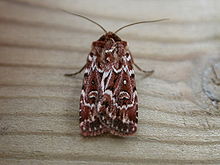- True Lover's Knot
-
This article is about the animal. For the rope knot, see True lover's knot.
True Lover's Knot 
Scientific classification Kingdom: Animalia Phylum: Arthropoda Class: Insecta Order: Lepidoptera Family: Noctuidae Genus: Lycophotia Species: L. porphyrea Binomial name Lycophotia porphyrea
(Denis & Schiffermüller, 1775)Synonyms - Noctua porphyrea [Schiffermüller], 1775
- Peridroma porphyrea (Denis and Schiffermueller, 1775)
- Noctua strigula Thunberg, 1792
- Phalaena (Noctua) varia Villers, 1789
- Phalaena (Noctua) concinna Esper, 1790
- Phalaena (Noctua) concinna Esper, 1804
- Noctua picta Fabricius, 1794
- Phalaena ericae Donovan, 1801
- Noctua ericae Haworth, 1809 (preocc. Phalaena ericae Donovan, 1801)
- Chersotis marmorea Graslin, 1863
- Agrotis strigula var. astur Culot, 1909
The True Lover's Knot (Lycophotia porphyrea) is a moth of the family Noctuidae. It has a nearly cosmopolitan distribution. In Europe it is found wherever its food plants grow. It is traditionally thought of as a species of heathland and moorland but it can often be found in places where heather and its relatives are in garden cultivation.
This is a small but attractive species, with a wingspan of 26–34 mm (individuals hatched in higher altitudes tend to be smaller than those from the lowlands). The forewings are brown, often tinged with purple and marked with a complex pattern of white markings which are supposed to recall a true lover's knot. The hindwings are grey or buff. It flies from the latter half of June to the beginning of August[1] and is attracted to light and the flowers of its food plants.
The larva is reddish-brown with pale lines and feeds on heather and related genera (e.g. Erica). The species overwinters as a larva.
References
Reading
- Chinery, Michael Collins Guide to the Insects of Britain and Western Europe 1986 (Reprinted 1991)
- Skinner, Bernard Colour Identification Guide to the Moths of the British Isles 1984

This Noctuinae-related article is a stub. You can help Wikipedia by expanding it.
